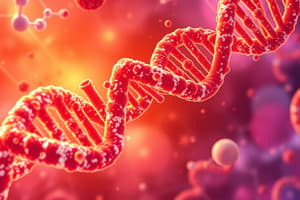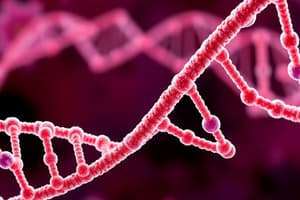Podcast
Questions and Answers
What is DNA replication?
What is DNA replication?
- The process of cell division
- The process of making a copy of DNA (correct)
- The process of protein synthesis
- The process of cellular respiration
What happens in step 1 of DNA replication?
What happens in step 1 of DNA replication?
Proteins called helicases separate the two original DNA strands.
What occurs in step 2 of DNA replication?
What occurs in step 2 of DNA replication?
Complementary nucleotides are added to each strand by DNA polymerases.
What is the outcome of step 3 in DNA replication?
What is the outcome of step 3 in DNA replication?
What is the function of DNA helicase?
What is the function of DNA helicase?
What is the role of DNA polymerase?
What is the role of DNA polymerase?
How does DNA replicate?
How does DNA replicate?
How is DNA replication different in prokaryotes and eukaryotes?
How is DNA replication different in prokaryotes and eukaryotes?
What are nucleotides made of?
What are nucleotides made of?
Match the following base pairs:
Match the following base pairs:
The last pair of chromosomes codes for sex.
The last pair of chromosomes codes for sex.
What is the significance of the genetic code?
What is the significance of the genetic code?
What did Griffith observe during his studies?
What did Griffith observe during his studies?
What did Watson and Crick contribute to genetics?
What did Watson and Crick contribute to genetics?
What is semi-conservative replication?
What is semi-conservative replication?
Flashcards are hidden until you start studying
Study Notes
DNA Replication Process
- DNA replication involves unwinding the DNA molecule and splitting the two strands, followed by the addition of new nucleotides to form two identical sequences.
- Step 1: Helicases are enzymes that separate the original DNA strands to initiate replication.
- Step 2: DNA polymerases add complementary nucleotides to each strand, ensuring accurate base pairing.
- Step 3: Two identical DNA molecules are produced, each identical to the original.
Key Molecular Structures
- DNA is composed of nucleotides, which consist of three components: a sugar (deoxyribose), a phosphate group, and a nitrogenous base.
- The structural conformation of DNA can be described as a double helix, resembling a twisted ladder.
Enzymes and Their Functions
- DNA helicase unwinds and separates the DNA double helix during replication.
- DNA polymerase catalyzes the formation of new DNA strands by adding nucleotides.
Differences Between Cell Types
- Prokaryotic DNA replication begins at a single site and occurs in opposite directions until the entire DNA loop is copied.
- Eukaryotic DNA replication starts at multiple sites along linear chromosomes, allowing for faster copying of the genetic material due to multiple replication forks.
Chromosomal Structures
- Humans have 23 pairs of chromosomes: 22 pairs are autosomes that code for all traits except sex, while the last pair determines the individual's gender.
- Autosomes are responsible for coding everything except for sex-related traits.
Genetic Concepts
- Complementary base pairing occurs through specific interactions: Adenine pairs with Thymine (A-T) and Cytosine pairs with Guanine (C-G).
- Semi-conservative replication involves using an old strand as a template and synthesizing a new strand alongside it.
Key Experiments and Discoveries
- Griffith's experiment demonstrated the process of transformation in pneumonia bacteria, showing that heat-killed bacteria could transfer disease-causing ability.
- Avery identified that DNA was the transforming factor responsible for genetic inheritance.
- Hershey and Chase worked with bacteriophages to show that DNA, not protein, carries genetic information.
- Franklin and Wilkins conducted x-ray diffraction studies that contributed to the understanding of DNA structure.
- Watson and Crick developed the double helix model of DNA, which earned them a Nobel Prize in Physiology or Medicine.
Important Genetic Tools
- The genetic code provides cells with critical information about their function and operation.
- Transformation examples include the transfer of pathogenic traits from heat-killed bacteria to live non-pathogenic cells.
Additional Concepts
- Base pairing is fundamental in stabilizing the DNA double helix through hydrogen bonds between complementary bases.
- Phosphate groups are essential components of DNA nucleotides, forming part of the backbone structure of DNA strands.
Studying That Suits You
Use AI to generate personalized quizzes and flashcards to suit your learning preferences.



